Santa Ana, early 1990s.
Gang violence is rampant.
From her home in the Motherhouse of the Sisters of St. Joseph of Orange on Batavia Street, Sister Eileen McNerney would see story after story about the bloodshed in the newspaper and think:
Reading about this is not enough.
With the help of Fr. Christopher Smith, then-pastor of St. Joseph Catholic Church in Santa Ana, Sister Eileen and three other sisters were able to lease an old house a few blocks from the church in a neighborhood rocked with significant gang activity.
“We’d look through our window and see gang members walking past our home and, 20 minutes later, hear the gunshots,” Sister Eileen recalled. “We needed to pray, but knew we needed to do more than that.”
That experience led to the founding of, in Spanish, Taller San Jose (St. Joseph Workshop), a goal-oriented program that targets young adults, ages 18-28, who are caught in a cycle of crime and poverty.
Today, that ministry, now called Hope Builders, has trained nearly 3,000 young adults in the construction, health care and office skills industries.
It’s an achievement that reflects one of the core missions of the order dating back to its founding in 1650, when a Jesuit priest in France, Jean Pierre Médaille, assisted a group of women involved in ministry with the poor.
“He instructed the sisters to be very prayerful and develop a strong relationship with God and when you’re praying, to look out the window and see what’s going on out there and minister to the needs of the community,” Sister Eileen said.
Working to keep youth out of gangs in Santa Ana is just one modern example of the countless ministries the Sisters of St. Joseph have been involved in over the last 372 years. By 1922, the sisters already had scaled the Alps, were established in India, had opened schools and hospitals in Scandinavia, had traveled by dog sled to northern Canada and had weathered persecution during the Mexican and Russian revolutions.
Their community in Orange marked the latest of their journeys from LePuy to Lyon, France; from France to St. Louis to upstate New York; onward to the Kansas plains and to LaGrange, Ill. At all stops, they experienced the push of adversity and the pull of missionary zeal.
This year, the Sisters of St. Joseph of Orange celebrate the centennial anniversary of the order’s relocation to Batavia Street in Orange from Northern California.
It’s time to enjoy the present, look to the future, and recall the many milestones that began in 1912, when Mother Bernard Gosselin established the Sisters of St. Joseph in Eureka.
The Sisters of St. Joseph were active in Southern California a handful of years before Bishop of Los Angeles John Cantwell blessed the property in Orange on June 23, 1922, after the sisters had officially taken possession of it on March 21 that same year (and officially became the Sisters of St. Joseph of Orange).
To mark the centennial of the relocation, a private Mass in the Sisters of St. Joseph of Orange’s Sacred Heart Chapel will be celebrated June 23.
That Mass follows an event held May 21, “Art in the Garden,” which raised $100,000 to benefit the ministries of the Sisters of St. Joseph of Orange.
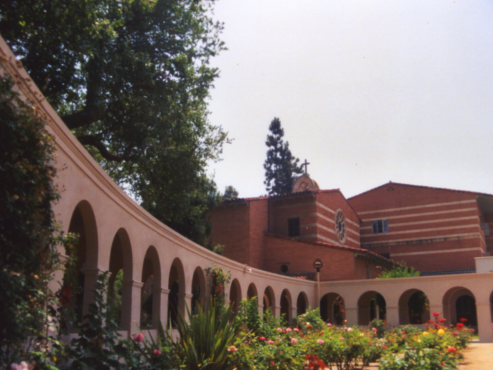
A SHOT OF THE MOTHERHOUSE GROUNDS IN THE EARLY 1990S. THE ARCHES CONNECT THE MOTHERHOUSE TO THE CHAPEL AND REGINA RESIDENCE. COURTESY OF THE SISTERS OF ST. JOSEPH
BEYOND HEALTHCARE AND EDUCATION
Catholics and others in Orange County closely associate the Sisters of St. Joseph of Orange with the hospital next door that bears their name.
St. Joseph Hospital, which the sisters opened in 1929, is one of Orange County’s first hospitals. Healthcare has, from the start, been a key ministry of the order. Two other hospitals – St. Jude in Fullerton and Mission in Mission Viejo – also serve Orange County residents.
The order also is well known for its involvement in education. In 1916 they took over administration of St. Joseph Catholic School in Santa Ana, one of Orange County’s oldest schools that was established in 1913.
Over the decades, the ministries of the Sisters of St. Joseph of Orange have greatly expanded to include rehabilitation programs, home health care, community education, primary care clinics and wellness programs, as well as helping new immigrants, feeding the hungry, giving shelter to the homeless and fostering spiritual development.
“We look to meet the needs of our neighbors,” Sister Mary Therese Sweeney said.
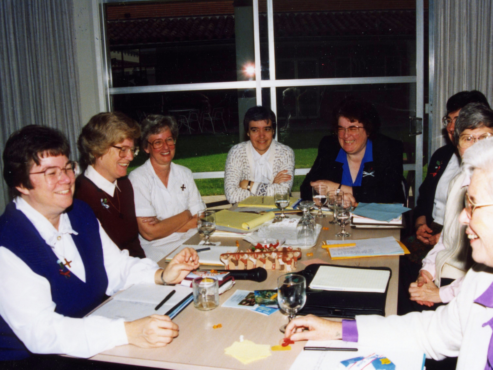
FROM LEFT: SRS. KATHERINE GRAY, MARIANNA GEMMET, JUDITH FERGUS, MARY BERNADETTE MCNULTY, PATRICIA HALEY, JUDITH DUGAN (OBSCURED), BERNICE JORDAN (OBSCURED), NANCY O’CONNOR. THE SISTERS ARE MEETING TO DISCUSS THE SPONSORSHIP COMMITTEE FOR ST. JOSEPH HEALTH SYSTEM IN 1991. COURTESY OF THE SISTERS OF ST. JOSEPH
A NEW HOME
The port city of Eureka, the largest coastal city between San Francisco and Portland, in Humboldt County, boasts gorgeous Pacific coastline and beautiful and massive old growth redwood trees.
But Mother Bernard knew the location wasn’t going to work long term.
For starters, the easiest way to get in and out of Eureka in the early 1900s was via ship.
Also, the Bishop of Sacramento, Patrick Keane, was scheduled to be consecrated on March 17, 1922, and once he became bishop, he would have more authority over the congregation. As Sister Mary Therese explained it, Mother Bernard knew the order had to relocate if it wanted to grow and flourish.
She visited Orange County when the sisters were active at St. Joseph Catholic School in Santa Ana.
“Mother Bernard felt Orange County had the most salubrious climate in the world and was very enchanted with it,” said Sister Mary Therese, who joined the order in 1964. Mother Bernard toured the 20-acre Batavia property – the former Burnham estate — following the recommendation of a local pastor and walked through its main structure, a Victorian mansion.
It had a ballroom.
“That was attractive to Mother Bernard,” says Sister Eileen, who joined the order in 1957. “She was determined to spare no expense in transforming the former ballroom into a chapel.”
The Burnham property was purchased for $90,000 and the Sisters of St. Joseph of Orange had a new home.
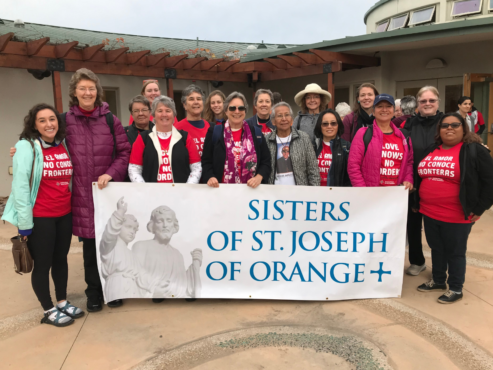
SEVENTEEN SISTERS AND PARTNERS PARTICIPATED IN THE “LOVE KNOWS NO BORDERS” INTERFAITH PUBLIC WITNESS IN RESPONSE TO LCWR’S NATIONAL CALL ACTION IN SUPPORT FOR OUR IMMIGRANT BROTHERS AND SISTERS IN DECEMBER 2018. THE PUBLIC WITNESS TOOK PLACE BY THE BEACH ON THE BORDER OF SAN DIEGO AND TIJUANA. COURTESY OF THE SISTERS OF ST. JOSEPH
SISTERS IN ACTION
Sister Eileen likes to describe herself and her fellow sisters as “active contemplatives” or “contemplatives in action.”
Following prayer with action is their forte.
At 90 strong, the Sisters of St. Joseph of Orange couldn’t do all they do without forging partnerships with several community organizations and leaders.
“I’ll be out and meet someone and they’ll say, ‘You only have 90 members? I thought you were 400 – you’re everywhere!’” Sister Eileen said.
She added: “We don’t have to have a complete cadre of sisters but a good collection of people who are good hearted and who need some influence and direction. We have zeal in our hearts and helping each other and partnering with others expands our ability to influence and touch people’s lives.”
Sister Mary Therese quotes a founding principle of the order:
‘We live and work to bring all people to union with God and one another serving their spiritual and corporal needs to the best of our ability. ‘
Over the years, examples abound of that principle being put into action.
When several communities of Mexican immigrants began forming in several pockets of Orange County, particularly after World War II, Orange County’s predominantly Irish born priests turned to the Sisters of St. Joseph. For many years, Sister Henrietta Sauvageau and her team took the lead in ministering to Spanish-speaking neighborhoods.
When waves of refugees from Vietnam arrived at Camp Pendleton after the fall of Saigon in 1975, the sisters went down to the Marine base to find out what their needs were.
“In a giant tent filled with Vietnamese people,” Sister Eileen recalled, “Sister Rosemarie Redding patiently explained how the Mass worked, speaking in English but communicating in the best way she could.”
Added Sister Eileen: “I was in Orange County in 1975, and I wasn’t looking out that window – but she was.
“We learned about the Vietnamese from the working experience of each other just like we learned about working with the deaf or people who live in Black communities in Compton or Chinese communities in San Francisco. A lot of what we learned about the world was from each other’s experiences.”
In another example of addressing the gang problem in Santa Ana, the sisters founded St. Joseph Ballet. In 1983, Sister Beth Burns launched the non-profit as a summer pilot dance program for at-risk youth. Today, it’s a thriving organization now called the Wooden Floor.
St. Joseph Hospital also opened a community clinic in a neighborhood of mostly Spanish-speaking residents that became a blueprint for other organizations seeking to improve access to health care for the underserved.
Other ministries of the Sisters of St. Joseph or Orange include the Center for Spiritual Development in Orange, which strives to nurture the spiritual lives of all who seek God, and a planned residential community, Villa St. Joseph, for 50 low-income seniors to be located inside the Motherhouse in Orange.
In the past few years, the Sisters of St. Joseph of Orange have been partnering with the University of San Francisco to train future nurses at facilities on Batavia Street.
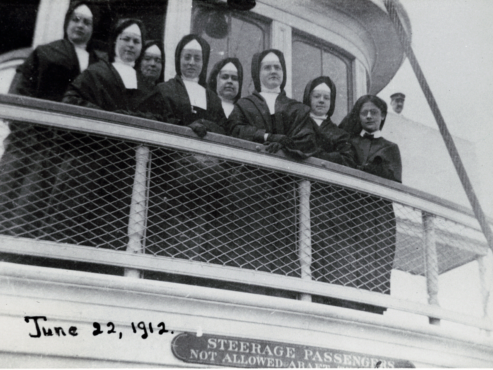
FROM LEFT: SRS. MARY JOSEPH GOSSELIN, ISABELLE AUBIN, ANGELA HUTTON, MOTHER BERNARD GOSSELIN, WINIFRED LAMBERT, IMMACULATTA HOYT, ELIZABETH LIRETTE, (POST.) FLORILDA FERRON, ON BOARD THE SS KILBURN STEAMSHIP FROM SAN FRANCISCO TO EUREKA IN 1912. THE SISTERS WERE ARRIVING FROM LA GRANGE, IL AT MOTHER BERNARD’S INVITATION. COURTESY OF THE SISTERS OF ST. JOSEPH
WHAT DO THE NEXT 100 YEARS HAVE IN STORE?
The Burnham mansion had a very wide wraparound porch — an ideal place to gather and chat.
“If I imagine Mother Bernard sitting there with a few of our newest members on this porch today,” Sister Eileen said, “I think she would ask them these questions: What needs do you see today in 2022, when you look out the windows of your world? How do you see yourselves as Sisters of St. Joseph bringing people together and bringing them to God now, and what is your plan to do so? What graces do you need to move forward in God’s name?”
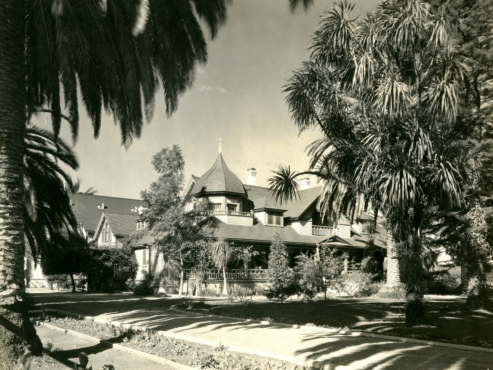
THE BURNHAM ESTATE IN ORANGE, IN 1922. THE CONGREGATION PURCHASED THE PROPERTY FOR $90,000 AS THE FIRST MOTHERHOUSE. COURTESY OF THE SISTERS OF ST. JOSEPH
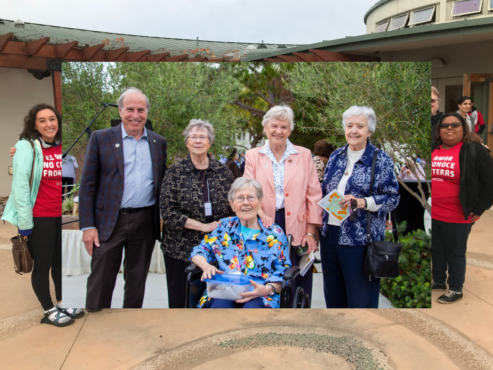
FROM LEFT: ROD HOCHMAN, CEO OF PROVIDENCE ST. JOSEPH HEALTH; SR. KATHERINE GRAY, FORMER GENERAL SUPERIOR 2001 – 2011; SR. MARY BETH INGHAM, CURRENT GENERAL SUPERIOR; SR. MARY BERNADETTE MCNULTY, TREASURER; AND SR. MADELEVA WILLIAMS, SEATED, AT THE ART IN THE GARDEN FUNDRAISING EVENT ON MAY 21. COURTESY OF THE SISTERS OF ST. JOSEPH
Sister Eileen paused.
“And then,” she added, “she would remind them of the words that she shared with our first members 100 years ago:
“’God will give you something special to do that He won’t ask of someone else, so pay attention.’”







